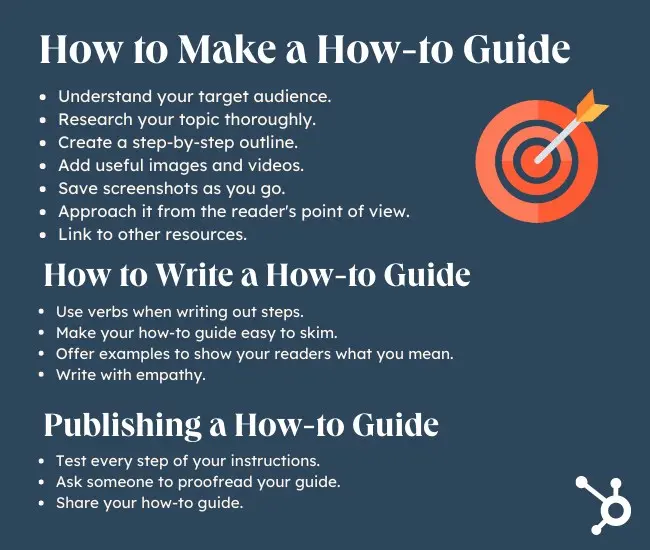
The irony doesn‘t escape me that I’m currently writing a how-to guide on … how-to guides. Fortunately, I've had my fair share of experiences writing how-to guides for HubSpot over the years.

![Download Now: 150+ Content Creation Templates [Free Kit]](https://no-cache.hubspot.com/cta/default/53/5478fa12-4cc3-4140-ba96-bc103eeb873e.png)
All fields are required.

Click this link to access this resource at any time.
If your business can reach those consumers with informative, relevant answers to their questions, those users will begin to see your brand as an authority on the topic.
Down the road, those readers you first attracted with a how-to guide could become customers and loyal brand advocates who spread the word about your products or services.
How-to guides make it easy to meet high expectations while sharing valuable information. But it takes work to make a great how-to.

Most people seeking how-to guides are beginners, so you must be an expert when writing the content. At the same time, you should also see the subject from a beginner's perspective.
Most how-to guides choose a starting point, which means you'll have to make an educated guess about where to start.
For example, if you‘re writing instructions on using a specific app, you probably wouldn’t make your first step turning on the computer. Instead, you would begin from the most logical place your average user should start.
Deciding on that first step will be easier once you know your target audience. Your target audience is a group of your ideal users. They will have similar habits and ideas that connect them.
And the better you get to know this audience, the easier it will be to make a how-to guide they'll love.
For this tip, start with online community forums like Quora or feedback from your community to figure out the top concerns or challenges your target audience might have.
That information will help you determine what content to include in your guide.
For instance, if you're writing “How to Create a Content Marketing Strategy,” for example, you could follow these steps:
This research will give you the information you need to create a how-to guide that addresses relevant concerns about your topic. The video below is an example of a how-to guide for content marketing that addresses specific audience pain points:
Even if you know a topic incredibly well, research isn't a step you should skip. Understanding a topic well can make writing a how-to guide on the subject more difficult, as you might make assumptions about what to cover.
So, follow this complete list of steps for your research.
For instance, you're writing a blog post, "How to Make an Omelette." Upon researching, you find Simply Recipe's post at the top of your Google search.

Diving into the post, you'll see Simply Recipe has sections including:
If you want to create your how-to guide on omelets, then you'll want to cover all – if not more – than what Simply Recipe has in its post.
As you research, don’t forget to fact-check your sources. You want to ensure your guide is trustworthy and won’t cause legal or other challenges for you later.
Now that you‘ve researched, it’s time to organize your ideas. First, combine your initial list of steps with any new ideas you learned during your research.
Next, create a step-by-step outline for your guide. This will mean making decisions that can impact how well the reader understands each step.
For instance, if you‘re writing "How to Take a Screenshot on a Mac," you’ll write down each specific action necessary to take a screenshot.
However, according to this how-to guide, you can create a screenshot on a Mac in four ways. So, the proper instructions for the user will depend on their computer and operating system.
You must decide when to introduce that extra information to your readers. Your readers will only bounce from your page if it's easy to find the answer to their question.
So, your outline can help you deliver your steps as quickly as possible — and in the correct order.
Many readers will also use your how-to guide as a list of instructions. You may need to revise your outline several times to ensure that each step in your strategy is straightforward.

Access ebook, blog post, CTA, case study, and more content templates.